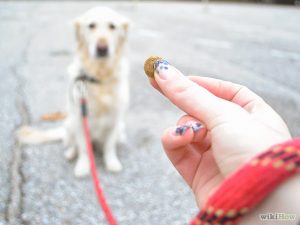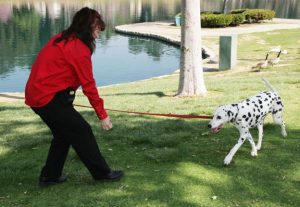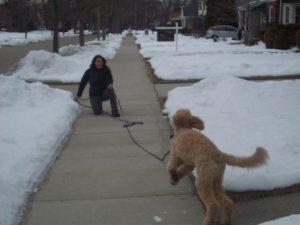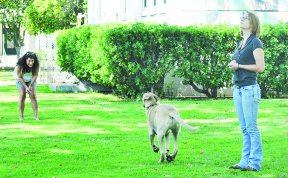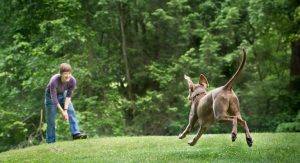Hi there,
Our dog is a black Labrador cross dog de Bordeaux and he’s big! But one of our main problems is when we let him off the lead because he’s not likely to come back for a treat! He’s not just my dog he’s a family dog in a busy household, we’re trying our best but we need some help with recall training, please email me back – your advice would mean so much and be incredibly useful!
Kind Regards,
Abi
Hi Abi,
Thanks for writing in with a very common issue dog owners contact me about, the recall, or Come command. This command, along with Stay are the ones I consider very important, as they both can relate to safety and saving a life.
I’m not sure if your dog comes when you call him inside the home, but this is the best place to start. At first, start with no distractions, and keep a very short distance. In the beginning I won’t even use a command. I will get the behavior first, then add the command. I assume you’ve been using the command Come so far. But if your dog has a history of ignoring this command, then I may very well choose a new command as the old one may have been ‘poisoned’ so to speak. If this is the case, I will usually name the new command Here, but you can choose any word you like. The shorter, the better.
As I mentioned before, I will get the behavior down first. Make sure to have small pieces of tasty treats on you. Not his kibble though, something of higher value. We want to teach the dog that returning to you is like winning the jackpot. To do this, we need to put in the work to build a solid foundation.
With your dog a few feet away from you, try getting him to move towards you, while you are backing up, with some kissy sounds, slapping your thighs, or anything that seems to excite him to move closer to you. When he does get closer to you, without having him sit, say Good, then reward him with a treat. It’s best to reach for his collar as you are rewarding him, so he learns that hands touching his collar is a great thing, and we don’t want him shying away from your hand in case you do have to grab his collar or put a leash on him.
Things will also go much smoother if you make sure to back away from him as you’re enticing him closer. This is a very mild form of the Chase Me game that most dogs love. The better he gets, the faster you want to move, as we want him to respond quickly.
Once you’ve repeated this a few times and he starts to understand what you want from him, then you can start adding the command. What matters is to only add it when he’s almost reached you. Don’t ask before he starts moving towards you. We want to pair the command with the actual behavior.
The better he gets, the more you can move up the timing of the command to when you actually ask him before he starts moving.
Now that he’s doing well in that particular part of the house, we can start working on him obeying during distractions before we start moving the exercise to a different part of the house. Small distractions to start, like someone moving, someone talking and so on. Keep it easy for him though. The goal is to set him up to succeed.
At this point, you may want to attach a long line to him. Six to ten feet long. It is very important that we never ask our dog to recall until we are 100% that he will come to us. It’s also very important to call our dog to us for anything they don’t enjoy, such as bath time or nail clipping time. In those instances, it’s better to go get your dog instead.
The long line is to ensure that the dog always comes back to us. If you ask, and your dog doesn’t respond to you, pick up the long line and gently bring him in, while enticing him in closer to you. When he gets to you, still mark the behavior with a Good and reward him. Even though you did most of the work getting him to come to you, we want to him to learn that coming back to you is the best thing in the world. We never want him to ignore the command.
Now you just need to rinse and repeat in different areas of your home, because dogs really don’t generalize that well. You’ll also need to work on recall with bigger distractions as well. If you can’t get him to come to you from playing with a toy or a person, you’ll never get him to come back to you when he’s with another dog, or sniffing something interesting.
A great exercise to use as well is having two people at opposite ends of a large room, or hallway. When person A calls him, person B moves up quickly to the half way distance between the two, ready to ask him to recall as soon as he is rewarded by person A. As soon as person B asks, they also move backwards very quickly to get the dog to recall quickly. While person A is rewarding, person A should be at the halfway mark, ready to call the dog.
This really helps to teach the dog to respond quickly to the cue with a very fun game. It also helps teach the dog to be recalled off of another person, someone who has food no less!
Once you’re ready to take the game outside, make sure to have the dog on a longer long line. Maybe fifteen to twenty feet long. Start in the backyard with no distractions, from an easy distance, slowly working your way up.
If you want to try anywhere else, make sure to work with a long line to set him up to succeed. When working outside, be it in the backyard or somewhere else, make sure to call him not only when you want to leave. This will ensure that he doesn’t learn that the recall command means end of fun. Let him go play again, many times.
This also helps teach him to check in with you, which is also very important for dogs to learn. Mark his checking in every time he does, then let him go play again.
Keep in mind to vary up the types of high valued rewards he’ll get as well. It’s great to keep him guessing.
This is how you can you teach your dog a reliable recall, in a nutshell. If you need any help, don’t be shy to contact a qualified trainer to help you out.
Good luck and Happy Training!
Meira
 Montreal Dog Blog Montreal's Online Dog Park
Montreal Dog Blog Montreal's Online Dog Park



